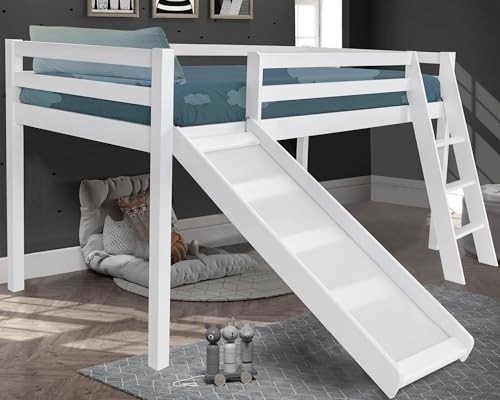Bunk Beds for Kids: A Comprehensive Guide
Bunk beds have actually been a popular choice for children's bedrooms for many years. They provide a space-saving option that takes full advantage of floor area, provides enjoyable climbing choices, and comes in a variety of designs that interest children's imaginations. This post checks out the advantages, considerations, designs, and security functions connected with bunk beds for children.
Benefits of Bunk Beds
Bunk beds present several benefits that make them an appealing option for families. Here are some crucial benefits:
Space Saving
- Bunk beds enable 2 or more kids to share a room without sacrificing space for play or other activities.
Affordable
- Acquiring a single bunk bed can be more cost-effective than buying two separate beds.
Enjoyable Factor
- Kids often see bunk beds as an enjoyable location to sleep and play, promoting a sense of experience.
Versatility
- Bunk beds are readily available in different setups, consisting of L-shaped, loft beds, and even convertible designs that can alter as kids grow.
Organization
- Many bunk beds feature integrated storage options, such as shelves and drawers, helping keep rooms arranged.
Secret Considerations Before Purchasing
Before purchasing a bunk bed, it's vital to consider certain factors, such as:
- Space Requirements
Step the room to make sure that there suffices vertical space, enabling sufficient headroom on the top bunk. - Age of Your Children
Consider their age and maturity. Numerous makers suggest that kids under six ought to not oversleep the top bunk due to security issues. - Weight Limit
It's crucial to check the weight limitations of the bunk bed for both the top and bottom bunks to make sure safety. - Style Preferences
Pick a style that matches the room's decor and the children's preferences. - Material
Bunk beds are available in various products, such as wood or metal. Each has its advantages and downsides concerning sturdiness and aesthetics.
Styles of Bunk Beds
Bunk beds come in different designs to fit various aesthetics and practical needs. Here's a list of some popular styles:
- Standard Bunk Beds
Traditional stacked beds that include 2 beds constructed one above the other. - Loft Beds
A bed raised high off the ground, with space underneath for a desk, play area, or storage. - L-Shaped Bunk Beds
2 beds arranged in an L-shape, providing more floor space and an unique design aspect. - Twin Over Full Bunk Beds
These choices feature a twin bed on the top and a full-sized bed on the bottom, accommodating older kids or adults. - Triple Bunk Beds
Developed for 3 kids, these beds generally include three stacked beds, suitable for larger households.
Safety Features to Consider
Ensuring the security of children utilizing bunk beds is vital. Here are some security features to search for before purchasing:
- Guardrails
A bunk bed must consist of sturdy guardrails on the leading bunk to prevent accidental falls. - Ladders
Ensure that the ladder is firmly connected and easy for children to browse safely. - Stability
Search for bunk beds with lower center of mass and broad bases to supply better stability. - Quality Construction
Pick beds made from resilient products that meet security standards, such as ASTM (American Society for Testing and Materials) guidelines.
FAQs About Bunk Beds
1. What age is appropriate for a leading bunk?Generally, kids aged 6 and older are advised for oversleeping the top bunk. 2. Are bunk Bunk Beds Sales lewisfranco.top for toddlers?Most specialists encourage against
positioning toddlers in the top bunk due to the
danger of falls and improper ladder usage. 3. Can bunk beds be separated?Many bunk beds are developed to be separated into 2 standalone beds,
offering added flexibility as children grow
. 4. How do I preserve a bunk bed?Regularly check for loose screws and use, keep mattresses tidy, and make sure that the bunk bed is
steady to lengthen its life expectancy. 5.
Are there any unique bed mattress requirements for bunk beds?Yes, bed mattress for bunk beds ought to fit snugly without leaving spaces. Usually, thinner bed mattress
(around 6 to 8 inches )are advised for leading bunks for security. Bunk beds offer a flexible, practical, and enjoyable solution for kids's sleeping arrangements, optimizing space while accommodating multiple kids in one room. By thinking about the important elements
of style, security, and space, moms and dads can make an informed decision when selecting the ideal bunk bed for their kids's requirements. With the right care and upkeep, a bunk bed can be a beloved piece of furniture that offers years of usage and satisfaction for kids. Summary Table of Bunk Bed Styles Design Description Best For Standard Bunk Beds Timeless style, two stacked beds Smaller spaces Loft Beds Raised bed with open space beneath Study or play locations L-Shaped Bunk Beds 2 beds in an L-shape
Included floor space Twin Over Full Twin on the top,
| complete on bottom Accommodating older children Triple | ||||||
|---|---|---|---|---|---|---|
| Bunk Beds | 3 stacked beds | Larger households By comprehending | the different alternatives offered, designated factors to consider for safety and functionality, and appropriate age guidelines, families | can pick the ideal bunk bed that not | only boosts their living space | but likewise makes sure a safe and |
| satisfying sleeping environment | for their children.

|
